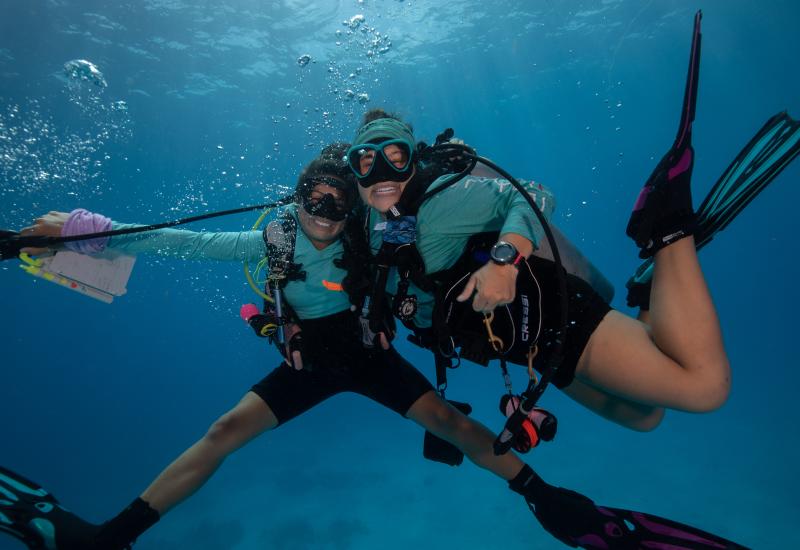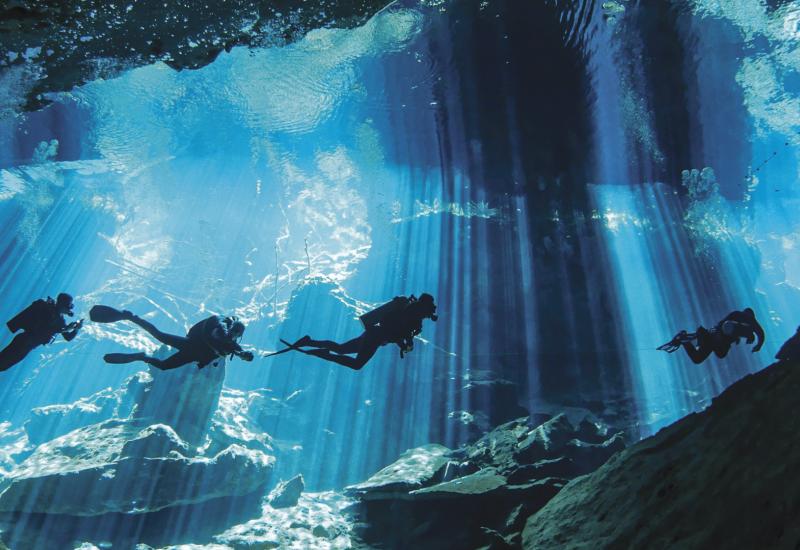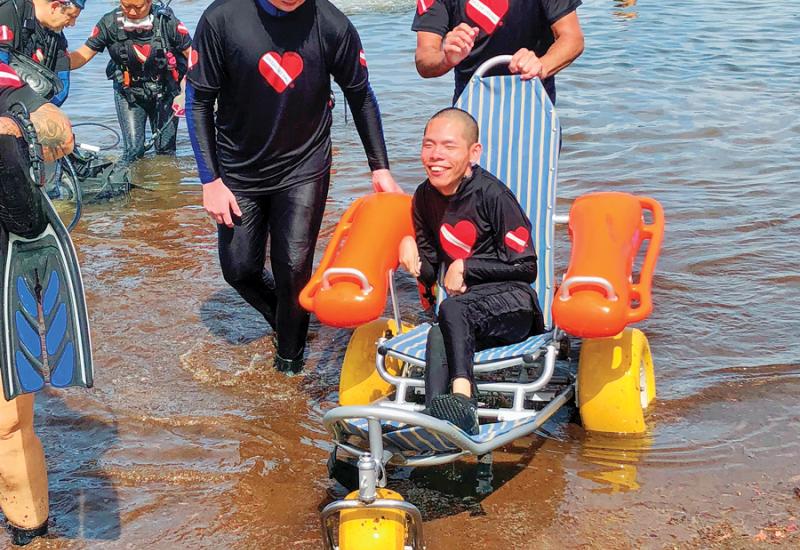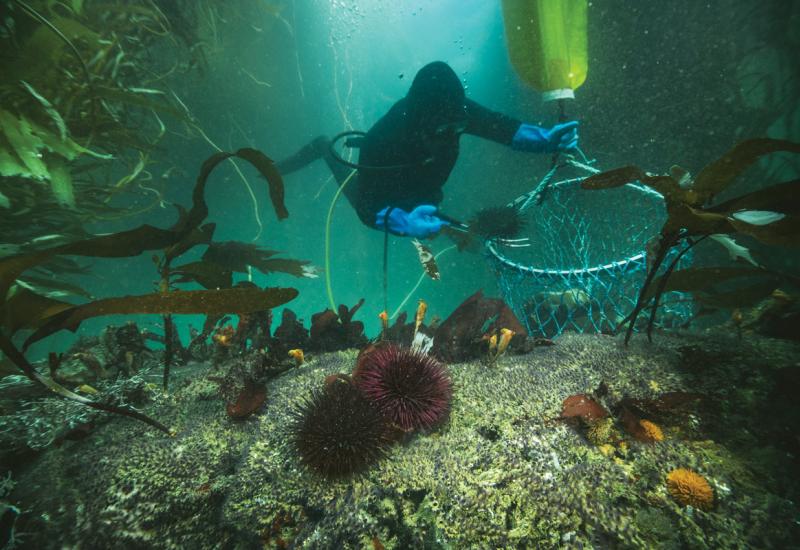Diving the World: Red Sea Adventure

Diving the World: Red Sea Adventure
Erin McFadden
Diving the World: Red Sea Adventure
The beginning of Erin McFadden's dream-come-true opportunity began with being named the 2011 Our World-Underwater Scholarship Society European Rolex Scholar. Here is her first blog about her yearlong experiences.
The Our World-Underwater Scholarship Society
For over 35 years, The Our World-Underwater Scholarship Society (OWUSS) has been granting one of the world’s most prodigious and distinctive scholarships. Together with generous backing from Rolex, this scholarship affords one young individual from North America, Europe and Australasia the chance to have unique firsthand experiences within the dive industry.
With an incredible web of hosts and sponsors spanning throughout the entire world, the OWUSS can provide a scholar with an extraordinary and unparalleled insight into the diving industry. What is more, these hosts and sponsors comprise the most esteemed individuals, companies, organisations and academic institutions within the diving industry. As such, the scholar is rapidly launched into the heart of the diving industry and is given an opportunity to start laying the foundation toward a successful and influential career within their chosen field.
Each scholar is offered comprehensive and hands-on experiences while visiting these renowned hosts and sponsors. A year that begins in the revered surroundings of the Explorers Club in New York City sees the scholars then embark upon a year filled with the most awe-inspiring opportunities. Scapa Flow, the Cocos Islands, Antarctica and Truk Lagoon are all feasible diving destinations for a scholar. In addition, receiving tuition and guidance from the world’s best instructors in an array of disciplines such as technical, commercial, scientific, cave and rebreather diving can provide a scholar with valuable and useful qualifications. A scholar’s itinerary is focused upon their interests, but breadth of experience is emphasised as unforseen passions are often stumbled upon.
As the 2011 European scholar, I describe my scholarship year so far as having been almost unbelievable. People often ask “what’s the catch?” There is none. The scholarship is about investing in the future of our oceans and giving young individuals the chance to achieve and accomplish something great. Previous scholars prove this ethos works.

Erin with Anthony Ruberecht, International TV Manager, Rolex SA
So far this year, I have surprised myself by thoroughly enjoying diving in my home country of Scotland - where a good drysuit and thermals is key! I have completed a number of courses including my GUE Fundamentals, PADI IDC and a UK commercial diving course. I have met and had the pleasure of being taught by the likes of Cristina Zenato, Phil Short and Doug Allan. This is truly one of the greatest scholarships the world has to offer.
First step in my journey: the Red Sea.

Erin is ready to get wet.
The Red Sea College
Sharm was once just a beach, “there was nothing here,” Guy Haywood, manager of the Red Sea College, recounted to me. Twenty years on, Sharm-el-Shiekh is a full-on tourist destination with hotels, bars, restaurants, dive centers and banana-boats in abundance. The boom is due to a combination of incredible reefs and a weather forecast that may as well run on repeat: sun, sun, sun. After first setting up camp here on the beach with his tent, dive gear and keen friends for company, Guy now manages one of the best-regarded, busiest and most successful dive centers not only in Egypt, but also throughout the world. Indeed, the Red Sea College has won Dive Centre of the Year five years running.
Guy had offered me the opportunity to complete my PADI Instructor Development Course (IDC) and Instructor Exam (IE) with the Red Sea College in Sharm. I am by no means the first scholar to be hosted by the Red Sea College – Guy has offered substantial training to many scholars over the years. Training a scholar to be a PADI professional is a considerable offer and I was extremely grateful for the opportunity.
Making the Decision
Taking the next step and becoming a PADI Open Water Scuba Instructor was something I had been contemplating for a couple of years. Having worked as a Divemaster I was already familiar with PADI courses and teaching, but I was well aware of the significant differences between the role of a Divemaster and that of an Instructor. Some people are very content being Divemasters — indeed, at one point, I believed being a Divemaster was enough for me. However, looking back at my experiences within the dive industry, and the dive centers and instructors I have worked with along the way, made me certain becoming an Instructor was right for me.
Each instructor has a specific manner and approach to teaching diving. I’m sure everyone can remember their first dive instructor, and the approach they took with you. It can certainly have a huge bearing on your overall opinion of diving. PADI has a slick and extremely effective and efficient structure to their courses. Instructors follow this structure during teaching, ensuring all standards are met and that their students achieve mastery. Yet, from my experiences to date, I know this structure does not prevent PADI instructors from delivering courses individual to them. Passions, charisma and principles, all specific to each instructor, are often what make a diving experience so memorable. In realizing this, I knew I was ready to embark upon my IDC and IE. When both PADI and the Red Sea College offered me the opportunity I pounced on it.

Erin getting fitted for diving dry.
The IDC: Comprehensive and Challenging
Entering into the IDC was somewhat daunting. Having completed the PADI e-learning and all the necessary preparations there was still a fear of the unknown within me. How could I learn all I needed to know to successfully teach people to dive in just two weeks? What I discovered as the IDC progressed was having a great Course Director is key — someone who will challenge you, push you and make you question yourself. Alex McNellan, owner of Rec and Tec in St Albans, UK, was our Course Director and he delivered a comprehensive and challenging IDC.
Alex started with three days of IDC preparation, which involved running my fellow candidate Jocky and I through our diving paces. What we should already know and have mastered as a Divemaster was being tested: theory, skills and standards. At this point I realized having worked as a Divemaster, and in varied dive center environments, was a real advantage. Having guided many divers, and having taught many refresher courses and assisted with other courses, I found the theory, skills and standards were well ingrained in my memory. Nevertheless, having time to reiterate all these things was crucial. When you enter into the IDC there is no time to review all this knowledge and as such it was very beneficial to have this grounding.
The IDC lasted for eight days. Long days spent in the classroom being crafted into brand-new and sparkling PADI instructors were interspersed with our confined and open water training dives. Together, Jocky and I learned how to present information to students; how to spot and rectify problems both above and below water; how to demonstrate skills most efficiently, and how to conduct PADI courses in an effective manner.
What is often unexpected with the IDC is how little time you spend diving. Because you are being taught how to teach - and how to teach while following stringent standards — you spend a lot of time in the classroom. It was overwhelming at times. After all, PADI has a lot of different courses on offer in an array of different disciplines. However, PADI has a well-established and rehearsed system of teaching, and consequently, instructors have an excellent array of materials to call upon to aid them in their teaching efforts. The PADI Instructor Manual and Guide to Teaching contain near enough everything you need to know. Referring to them throughout the IDC, as well as throughout your career, is strongly encouraged. In addition, underwater slates help keep you on track during training dives as they list what is required of the student during each dive. A large part of the IDC was focused on becoming familiar with these materials and using them effectively and efficiently.
Surviving the IE
Once I had figured out my way around the PADI materials and absorbed information to the point of saturation regarding standards, skills, teaching and theory, I was all set for the IE. I was undeniably anxious. Approximately 40 candidates from various dive centers around Sharm were joined in mass apprehension. Our examiners were lighthearted and welcoming, but that did nothing to quell my fear. Beginning with the written exams in dive theory and PADI standards, we then progressed onto the confined and open water exams. During these exams you first brief and demonstrate your allocated skill. You then watch your “students” intently as they perform the skill. Intentional problems are thrown into the mix and if you don’t spot them you’re out! Unsurprisingly, these intentional problems caused the most anxiety and chitter chatter regarding what possible problems could crop up surrounded us for the two days of the exam.

Erin and the rest of the IE candidates.
As Jocky and I both traversed the trying experience that is the IE, successfully passing each section en route, we became ever closer to becoming PADI OWSI. When we each stood up after giving our final briefings, our triumph was secured via a firm handshake. It was only upon entering into the in-water sections of the IE that Jocky and I came to realize just how well Alex had prepared us. Undoubtedly, he had trained us to a standard far above what was expected from us, and we were both most appreciative for this.
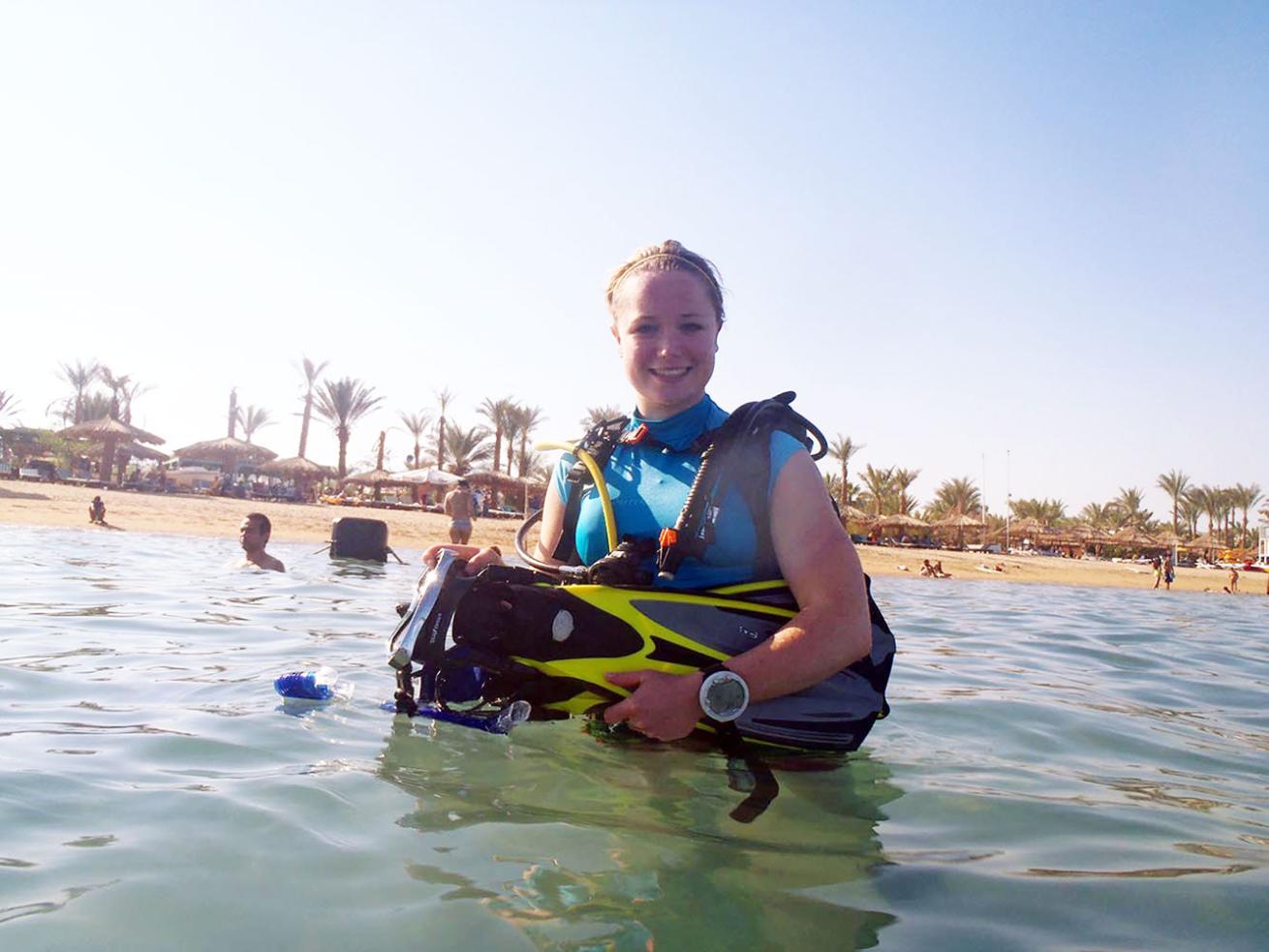
Erin McFadden
Diving the World: Red Sea Adventure
The beginning of Erin McFadden's dream-come-true opportunity began with being named the 2011 Our World-Underwater Scholarship Society European Rolex Scholar. Here is her first blog about her yearlong experiences.
The Our World-Underwater Scholarship Society
For over 35 years, The Our World-Underwater Scholarship Society (OWUSS) has been granting one of the world’s most prodigious and distinctive scholarships. Together with generous backing from Rolex, this scholarship affords one young individual from North America, Europe and Australasia the chance to have unique firsthand experiences within the dive industry.
With an incredible web of hosts and sponsors spanning throughout the entire world, the OWUSS can provide a scholar with an extraordinary and unparalleled insight into the diving industry. What is more, these hosts and sponsors comprise the most esteemed individuals, companies, organisations and academic institutions within the diving industry. As such, the scholar is rapidly launched into the heart of the diving industry and is given an opportunity to start laying the foundation toward a successful and influential career within their chosen field.
Each scholar is offered comprehensive and hands-on experiences while visiting these renowned hosts and sponsors. A year that begins in the revered surroundings of the Explorers Club in New York City sees the scholars then embark upon a year filled with the most awe-inspiring opportunities. Scapa Flow, the Cocos Islands, Antarctica and Truk Lagoon are all feasible diving destinations for a scholar. In addition, receiving tuition and guidance from the world’s best instructors in an array of disciplines such as technical, commercial, scientific, cave and rebreather diving can provide a scholar with valuable and useful qualifications. A scholar’s itinerary is focused upon their interests, but breadth of experience is emphasised as unforseen passions are often stumbled upon.
As the 2011 European scholar, I describe my scholarship year so far as having been almost unbelievable. People often ask “what’s the catch?” There is none. The scholarship is about investing in the future of our oceans and giving young individuals the chance to achieve and accomplish something great. Previous scholars prove this ethos works.

Erin with Anthony Ruberecht, International TV Manager, Rolex SA
So far this year, I have surprised myself by thoroughly enjoying diving in my home country of Scotland - where a good drysuit and thermals is key! I have completed a number of courses including my GUE Fundamentals, PADI IDC and a UK commercial diving course. I have met and had the pleasure of being taught by the likes of Cristina Zenato, Phil Short and Doug Allan. This is truly one of the greatest scholarships the world has to offer.
First step in my journey: the Red Sea.

_Erin is ready to get wet._
The Red Sea College
Sharm was once just a beach, “there was nothing here,” Guy Haywood, manager of the Red Sea College, recounted to me. Twenty years on, Sharm-el-Shiekh is a full-on tourist destination with hotels, bars, restaurants, dive centers and banana-boats in abundance. The boom is due to a combination of incredible reefs and a weather forecast that may as well run on repeat: sun, sun, sun. After first setting up camp here on the beach with his tent, dive gear and keen friends for company, Guy now manages one of the best-regarded, busiest and most successful dive centers not only in Egypt, but also throughout the world. Indeed, the Red Sea College has won Dive Centre of the Year five years running.
Guy had offered me the opportunity to complete my PADI Instructor Development Course (IDC) and Instructor Exam (IE) with the Red Sea College in Sharm. I am by no means the first scholar to be hosted by the Red Sea College – Guy has offered substantial training to many scholars over the years. Training a scholar to be a PADI professional is a considerable offer and I was extremely grateful for the opportunity.
Making the Decision
Taking the next step and becoming a PADI Open Water Scuba Instructor was something I had been contemplating for a couple of years. Having worked as a Divemaster I was already familiar with PADI courses and teaching, but I was well aware of the significant differences between the role of a Divemaster and that of an Instructor. Some people are very content being Divemasters — indeed, at one point, I believed being a Divemaster was enough for me. However, looking back at my experiences within the dive industry, and the dive centers and instructors I have worked with along the way, made me certain becoming an Instructor was right for me.
Each instructor has a specific manner and approach to teaching diving. I’m sure everyone can remember their first dive instructor, and the approach they took with you. It can certainly have a huge bearing on your overall opinion of diving. PADI has a slick and extremely effective and efficient structure to their courses. Instructors follow this structure during teaching, ensuring all standards are met and that their students achieve mastery. Yet, from my experiences to date, I know this structure does not prevent PADI instructors from delivering courses individual to them. Passions, charisma and principles, all specific to each instructor, are often what make a diving experience so memorable. In realizing this, I knew I was ready to embark upon my IDC and IE. When both PADI and the Red Sea College offered me the opportunity I pounced on it.

Erin getting fitted for diving dry.
The IDC: Comprehensive and Challenging
Entering into the IDC was somewhat daunting. Having completed the PADI e-learning and all the necessary preparations there was still a fear of the unknown within me. How could I learn all I needed to know to successfully teach people to dive in just two weeks? What I discovered as the IDC progressed was having a great Course Director is key — someone who will challenge you, push you and make you question yourself. Alex McNellan, owner of Rec and Tec in St Albans, UK, was our Course Director and he delivered a comprehensive and challenging IDC.
Alex started with three days of IDC preparation, which involved running my fellow candidate Jocky and I through our diving paces. What we should already know and have mastered as a Divemaster was being tested: theory, skills and standards. At this point I realized having worked as a Divemaster, and in varied dive center environments, was a real advantage. Having guided many divers, and having taught many refresher courses and assisted with other courses, I found the theory, skills and standards were well ingrained in my memory. Nevertheless, having time to reiterate all these things was crucial. When you enter into the IDC there is no time to review all this knowledge and as such it was very beneficial to have this grounding.
The IDC lasted for eight days. Long days spent in the classroom being crafted into brand-new and sparkling PADI instructors were interspersed with our confined and open water training dives. Together, Jocky and I learned how to present information to students; how to spot and rectify problems both above and below water; how to demonstrate skills most efficiently, and how to conduct PADI courses in an effective manner.
What is often unexpected with the IDC is how little time you spend diving. Because you are being taught how to teach - and how to teach while following stringent standards — you spend a lot of time in the classroom. It was overwhelming at times. After all, PADI has a lot of different courses on offer in an array of different disciplines. However, PADI has a well-established and rehearsed system of teaching, and consequently, instructors have an excellent array of materials to call upon to aid them in their teaching efforts. The PADI Instructor Manual and Guide to Teaching contain near enough everything you need to know. Referring to them throughout the IDC, as well as throughout your career, is strongly encouraged. In addition, underwater slates help keep you on track during training dives as they list what is required of the student during each dive. A large part of the IDC was focused on becoming familiar with these materials and using them effectively and efficiently.
Surviving the IE
Once I had figured out my way around the PADI materials and absorbed information to the point of saturation regarding standards, skills, teaching and theory, I was all set for the IE. I was undeniably anxious. Approximately 40 candidates from various dive centers around Sharm were joined in mass apprehension. Our examiners were lighthearted and welcoming, but that did nothing to quell my fear. Beginning with the written exams in dive theory and PADI standards, we then progressed onto the confined and open water exams. During these exams you first brief and demonstrate your allocated skill. You then watch your “students” intently as they perform the skill. Intentional problems are thrown into the mix and if you don’t spot them you’re out! Unsurprisingly, these intentional problems caused the most anxiety and chitter chatter regarding what possible problems could crop up surrounded us for the two days of the exam.

Erin and the rest of the IE candidates.
As Jocky and I both traversed the trying experience that is the IE, successfully passing each section en route, we became ever closer to becoming PADI OWSI. When we each stood up after giving our final briefings, our triumph was secured via a firm handshake. It was only upon entering into the in-water sections of the IE that Jocky and I came to realize just how well Alex had prepared us. Undoubtedly, he had trained us to a standard far above what was expected from us, and we were both most appreciative for this.

